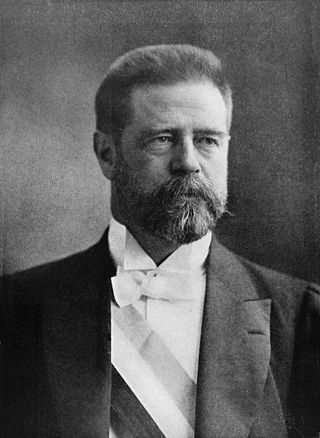
Germán Riesco Errázuriz was a Chilean political figure, and he served as President of Chile between 1901 and 1906.
Events in the year 2006 in Argentina.
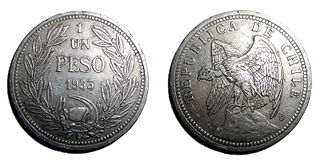
The economy of Chile has shifted substantially over time from the heterogeneous economies of the diverse indigenous peoples to an early husbandry-oriented economy and finally to one of raw material export and a large service sector. Chile's recent economic history has been the focus of an extensive debate from which neoliberalism acquired its modern meaning.
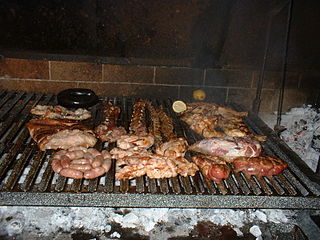
Beef is a key component of traditional Argentine cuisine.
Argentina is one of the world's largest producers of beef. It is also the third-largest exporter, and has the world's highest consumption rate. On 8 March 2006, President Néstor Kirchner took the drastic measure of banning all exports of beef for a period of 180 days, in order to stop continuous price rises.

The 2006 student protests in Chile were a series of ongoing student voice protests carried out by high school students across Chile against the privatization of the Chilean education system, implemented by dictator Augusto Pinochet in the 1970's. The protests peaked on May 30th, when 790,000 students adhered to strikes and protests throughout the country, becoming Chile's largest student demonstration of the past three decades and the first political crisis of president Michelle Bachelet's administration.

Rodeo is a traditional equestrian sport in Chile, declared the national sport in 1962.

The Santa María School massacre was a massacre of striking workers, mostly saltpeter works (nitrate) miners, along with wives and children, committed by the Chilean Army in Iquique, Chile on December 21, 1907. The number of victims is undetermined but is estimated to be over 2,000. It occurred during the peak of the nitrate mining era, which coincided with the Parliamentary Period in Chilean political history (1891–1925). With the massacre and an ensuing reign of terror, not only was the strike broken, but the workers' movement was thrown into limbo for over a decade. For decades afterward there was official suppression of knowledge of the incident, but in 2007 the government conducted a highly publicized commemoration of its centenary, including an official national day of mourning and the reinterment of the victims' remains.

Agriculture in Chile encompasses a wide range of different activities due to its particular geography, climate, geology and human factors. Historically agriculture is one of the bases of Chile's economy, now agriculture and allied sectors—like forestry, logging and fishing—account only for 4.9% of the GDP as of 2007 and employed 13.6% of the country's labor force. Some major agricultural products of Chile include grapes, apples, onions, wheat, corn, oats, peaches, garlic, asparagus, beans, beef, poultry, wool, fish and timber. Due to its geographical isolation and strict customs policies, Chile is free from diseases such as Mad Cow, fruit fly and Phylloxera, this plus being located in the southern hemisphere and its wide range of agriculture conditions are considered Chile's main comparative advantages. However, the mountainous landscape of Chile limits the extent and intensity of agriculture so that arable land corresponds only to 2.62% of the total territory.
The direct negotiations between Chile and Argentina about the islands and maritime rights in Beagle conflict began after the Queen Elizabeth II of the United Kingdom announced on 2 May 1977 the judgement of the Beagle Channel Arbitration to the governments of both countries. The court ruled that the islands and all adjacent formations belonged to Chile. The direct negotiations finished with the Act of Montevideo on 9 January 1979, where both countries accept the papal mediation after Argentina's call off of the Operation Soberanía. This was the most dangerous phase of the Beagle Conflict and there was a real possibility of open warfare.
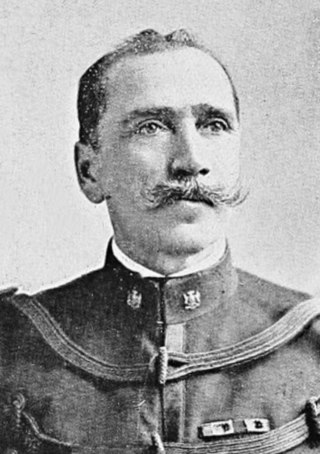
Roberto Silva Renard was a Chilean military and political figure who served in the War of the Pacific and the 1891 Chilean Civil War. He is mostly remembered as the military chief that carried out the Santa María of Iquique School massacre in 1907, where more than 2,000 striking saltpeter miners, along with their wives and children, were killed.
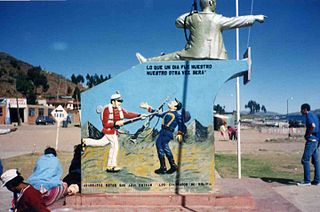
Anti-Chilean sentiment refers to the historical and current resentment towards Chile, Chileans, or Chilean culture. Anti-Chilean sentiment is most prevalent among Chile's neighbors Argentina, Bolivia and Peru.

The 2011–2013 Chilean protests – known as the Chilean Winter or the Chilean Education Conflict – were a series of student-led protests across Chile, demanding a new framework for education in the country, including more direct state participation in secondary education and an end to the existence of profit in higher education. Currently in Chile, only 45% of high school students study in traditional public schools and most universities are also private. No new public universities have been built since the end of the Chilean transition to democracy in 1990, even though the number of university students has increased.

Nicomedes Guzmán, was a Chilean writer, editor, poet, and novelist.

The anarchist movement in Chile emerged from European immigrants, followers of Mikhail Bakunin affiliated with the International Workingmen's Association, who contacted Manuel Chinchilla, a Spaniard living in Iquique. Their influence could be perceived at first within the labour unions of typographers, painters, builders and sailors. During the first decades of the 20th century, anarchism had a significant influence on the labour movement and intellectual circles of Chile. Some of the most prominent Chilean anarchists were: the poet Carlos Pezoa Véliz, the professor Dr Juan Gandulfo, the syndicalist workers Luis Olea, Magno Espinoza, Alejandro Escobar y Carballo, Ángela Muñoz Arancibia, Juan Chamorro, Armando Triviño and Ernesto Miranda, the teacher Flora Sanhueza, and the writers José Domingo Gómez Rojas, Fernando Santiván, José Santos González Vera and Manuel Rojas. At the moment, anarchist groups are experiencing a comeback in Chile through various student collectives, affinity groups, community and cultural centres, and squatting.

Agriculture in Chile has a long history dating back to the Pre-Hispanic period. Indigenous peoples practised varying types of agriculture, from the oases of the Atacama Desert to as far south as the Guaitecas Archipelago. Potato was the staple food in the populous Mapuche lands. Llama and chilihueque herding was practised by various indigenous groups.
[Chile] is rich in pastures and cultivated fields, in which all kind of animals and plants can be breed or grown, there is plenty of very beautiful wood for making houses, and plenty of firewood, and rich gold mines, and all land is full of them...

The 2019–2022 Chilean protests, known in Chile as the Estallido Social, are a series of massive demonstrations and severe riots that originated in Santiago and spread to all regions of Chile, with a greater impact in the regional capitals, developed mainly between October 2019 and March 2020. Civil protests took place throughout Chile in response to a raise in the Santiago Metro's subway fare, a probity crisis, cost of living, university graduate unemployment, privatisation and inequality prevalent in the country.

La marcha más grande de Chile was a demonstration that took place in Santiago de Chile on October 25, 2019, as part of the 2019–2021 Chilean protests. It was considered a "peaceful concentration" by local authorities and by the national and international press. In Santiago alone, more than 1.2 million people participated, the biggest protest concentration in Chile's modern history, surpassing the record settled in 1988, by the closing rally of the "No" option in the 1988 national plebiscite. In total, it is believed that more than 3 million people across the country participated in the protest.

Luis Carlos Fanta Tomaszewski, known as Carlos Fanta, was a Chilean football player, manager, referee, director of football, journalist, and pharmacist.
















